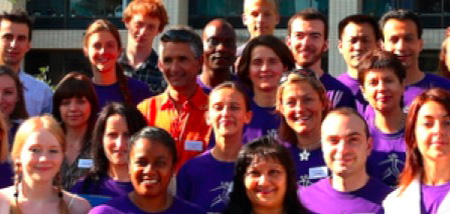A study published today in the Archives of Internal Medicine by researchers at King’s College London, has shown that people who exercise more in their free time appear to be biologically younger than their more sedentary counterparts.
Professor Tim Spector and Dr Lynn Cherkas from the Twin Research & Genetic Epidemiology Unit at King’s College London, together with Professor Abraham Aviv in New Jersey, looked for evidence of ageing at a molecular level in the population by analysing telomeres, which cap the end of chromosomes in our cells and protect them from damage.
With age, our telomeres shorten, leaving us more susceptible to cell damage, which causes disease. However, there is considerable variation between people, and recent research has already highlighted several lifestyle factors such as smoking and obesity that are associated with shorter than average telomeres.
Physical activity has already been shown to have a major impact on health: frequent exercisers display reduced cardiovascular risk and are at lower risk for type 2 diabetes, mellitus, cancer, hypertension, obesity and osteoporosis. However, despite the known benefits of physical activity, inactivity continues to be a major public health problem, increasing the propensity to age-related diseases and death.
This study suggests that a sedentary lifestyle may diminish life expectancy not only by predisposing to age-related diseases but also because it may influence the ageing process itself.
The investigators recruited 2,401 volunteers from the UK aged 18-81 years onto the study. All completed questionnaires detailing their levels of physical activity during leisure time in the last 12 months, in addition to a wide range of health and lifestyle issues.
The investigators found that telomere length decreased steadily with age and there was a significant association between increasing physical activity and longer telomere length even after adjusting for other measurable influences (body mass index (BMI), smoking, and socioeconomic status (SES).
Dr Cherkas explains: ‘Overall, the difference in telomere length between the most active subjects and the inactive subjects corresponds to around nine years of ageing.’
The study population was comprised of MZ twins (Identical twins) and DZ twins (Fraternal Twins). Comparing the telomere lengths of twins who were raised together but take different amounts of exercise, reduces the effect of genetic and environmental variation and so provides a more powerful test of the hypothesis. This design revealed that on average, the telomeres of the more active twin were significantly longer that those of the less active twin, confirming previous results.
Professor Spector states: ‘Our study, performed on a large cohort, indicates that differences in telomere length between active and inactive individuals cannot be explained by variations in genes, smoking, BMI and SES. A sedentary lifestyle appears to have an effect on telomere dynamics – thus providing a powerful message that could be used by clinicians to promote the potentially anti-aging effect of regular exercise.’
Notes to editors
The Twin Research Unit
The Twin Research Unit at King’s College London has a database of 10,000 twins and studies a wide variety of diseases and traits and is always looking for more adult twin volunteers, male or female, identical or non-identical to help with their studies. To volunteer or for more information please phone: 020 7188 5555 or visit the website:http://www.twinsUK.ac.uk
King’s College London
King’s College London is one of the top 25 universities in the world (Times Higher 2007) and the fourth oldest in England. A research-led university based in the heart of London, King’s has 19,700 students from more than 140 countries, and 5,400 employees. King’s has an outstanding reputation for providing world-class teaching and cutting-edge research. The College is in the top group of UK universities for research earnings and has an annual income of approximately £400 million. An investment of £500 million has been made in the redevelopment of its estate.
King’s has a particularly distinguished reputation in the humanities, law, social sciences, the health sciences, natural sciences and engineering, and has played a major role in many of the advances that have shaped modern life, such as the discovery of the structure of DNA. It is the largest centre for the education of healthcare professionals in Europe and is home to five Medical Research Council Centres – more than any other university.
Further information
Katherine Moore, Public Relations Department
Email: kate.moore@kcl.ac.uk
Tel: 020 7848 4334






